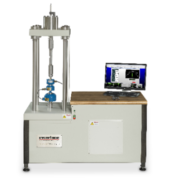Why Use a Limit Switch in Force Measurement?
 In the world of force measurement, load cells reign supreme. Their accuracy and precision in measuring force make them indispensable for testing and design. However, certain use cases may require a limit switch to ensure optimal functionality and safety.
In the world of force measurement, load cells reign supreme. Their accuracy and precision in measuring force make them indispensable for testing and design. However, certain use cases may require a limit switch to ensure optimal functionality and safety.
What is a Limit Switch? A limit switch is an electromechanical device that acts like a trigger, activating when a physical object encounters it. This simple mechanism translates to powerful capabilities in force measurement applications.
An easy way to add a limit switch feature in test and measurement is through instrumentation. Our 9825 General Purpose Indicator, for example, offers limit switch functionality.
The Dual Role of Limit Switches in Force Measurement
#1 Overload Protection: Load cells are sensitive instruments. Applying excessive force beyond the specifications and repeatability can damage the measurement device. Overload protection features, such as limit switches or stoppers, can be used to prevent load cells from being subjected to excessive forces or moments. This can help to prevent damage to the load cell and ensure accurate measurements.
TIP: If this is a concern in your testing plan, Interface offers overload protection load cells designed to perform above capacity. Our most popular load cells include SMT Overload Protected S-Type Load Cell, MBI Overload Protected Miniature Beam Load Cell, and MRTP Miniature Overload Protected Flange Style Reaction Torque Transducer.
On the other hand, adding limit switches to act as a safety net is valuable as part of overall systems. They are ideal for halting operations when a predefined force threshold is exceeded, preventing damage to the load cell and ensuring operator safety. Think of them as safety valves that prevent a pressure cooker from exploding.
#2 System Accuracy and Control: Beyond protection, limit switches contribute to the precision of force measurement systems. By providing feedback to the system, they help refine measurements and control machinery with pinpoint accuracy. For example, a limit switch in a tensile testing machine can trigger the machine to stop when a material reaches its yield point, precisely measuring its strength.
Use Cases for Limit Switches
A limit switch is a guardian within the force measurement system, providing critical safeguards and enhancing overall system performance.
Compression Testing
A limit switch can prevent the testing machine from crushing the test subject completely, preserving the equipment and ensuring accurate data collection. For example, wood compression testing tests the strength, stiffness, and structural integrity of different types of wood. This is necessary for different industries where wood is implemented, such as construction, furniture making, and other scenarios. A force measurement system is needed during the testing operations. The 1331 Compression-Only Load Cell is installed in the compression load frame, and the force results are sent to a computer using the INF-USB3 Universal Serial Bus Single Channel PC Interface Module. Wood Compression Testing App Note
Fatigue Testing
Measuring fatigue is one of the most popular uses for load cells in testing. This applies to all types of products, parts, and components. In aerospace applications, materials undergo extreme and rigorous fatigue testing to simulate real-world stress. Limit switches ensure the forces applied remain within safe limits, protecting the load cell and maintaining the integrity of the test. Read more about Fatigue Testing Solutions.
Industrial Automation
On automated assembly lines, limit switches integrated with load cells ensure components are handled with the correct force, preventing damage and ensuring consistent quality. This might apply to robotics or processing equipment like conveyors or mixers. Learn more about industrial automation applications.
Lifting and Moving Equipment
Cranes and hoists rely on load cells to measure the weight of the lifted load. Limit switches act as a crucial safety mechanism, preventing the crane from lifting beyond its capacity and potentially causing a catastrophic accident. They are frequently integrated into construction, maritime, and industrial equipment.
Worker Safety
In manufacturing environments where workers interact with heavy machinery, limit switches can be integrated with load cells to create safety zones. If a worker enters a designated area, the limit switch triggers a shutdown or slowdown of the machinery, preventing injuries. Check out: Force Sensors Automate Safety Systems in Industrial Facilities
Benefits of Integrating Limit Switches
- Enhanced Durability: Limit switches safeguard load cells from overload, extending their lifespan and reducing the need for costly replacements.
- Safety First: Protecting equipment is important, but operator safety is paramount. Limit switches help prevent accidents caused by excessive force.
- Precision and Repeatability: Limit switches contribute to consistent and reliable measurements, crucial for quality control and research.
Limit switches are an essential companion to force measurement systems, especially in environments where precision, safety, and reliability are paramount. Whether in industrial automation, material testing, or aerospace engineering, the strategic use of limit switches with load cells is good for both performance and durability.
Check with our application engineers to explore whether fatigue-rated load cells, overload protection, or instrumentation are the optimal solutions for your project.








